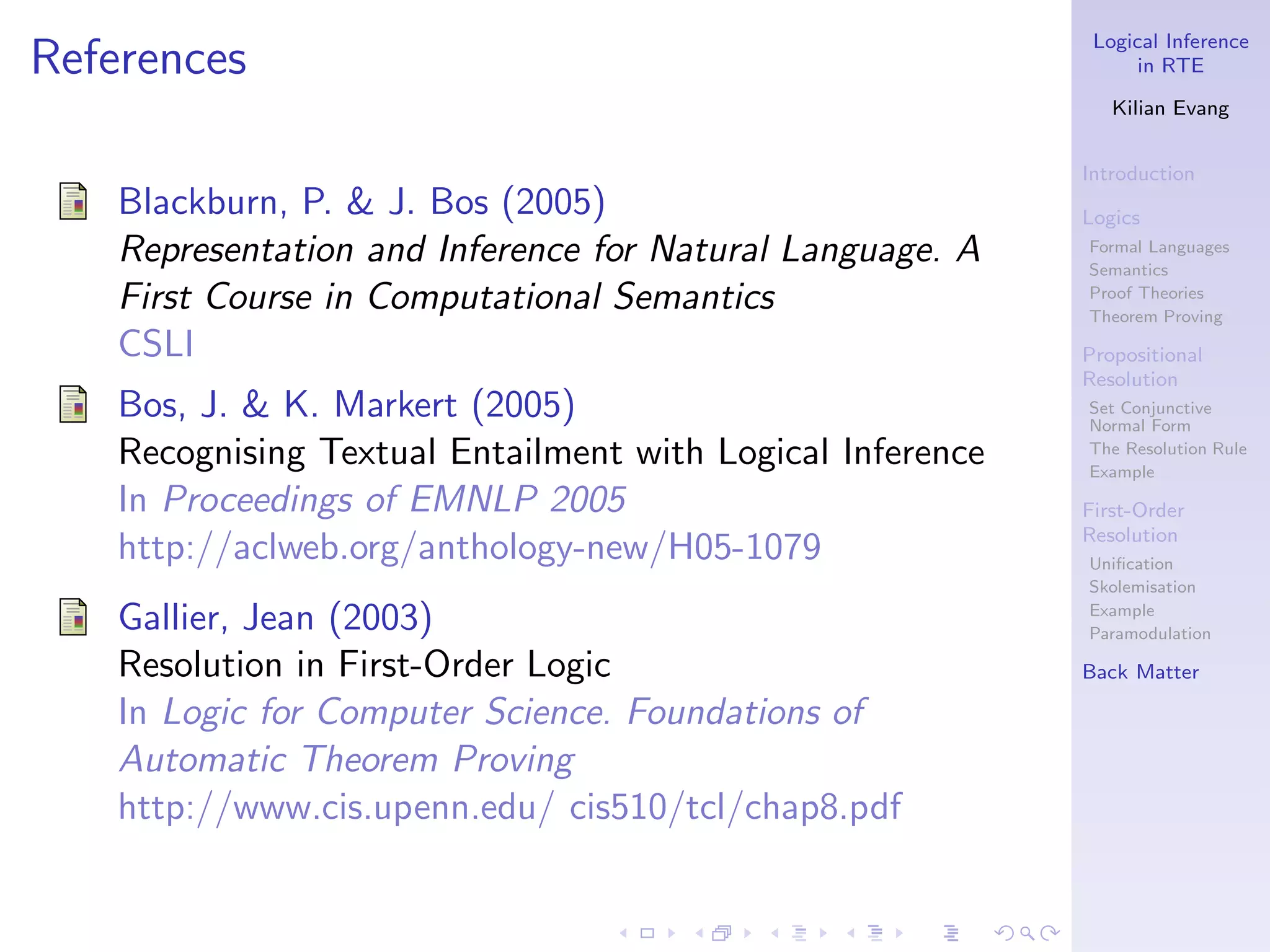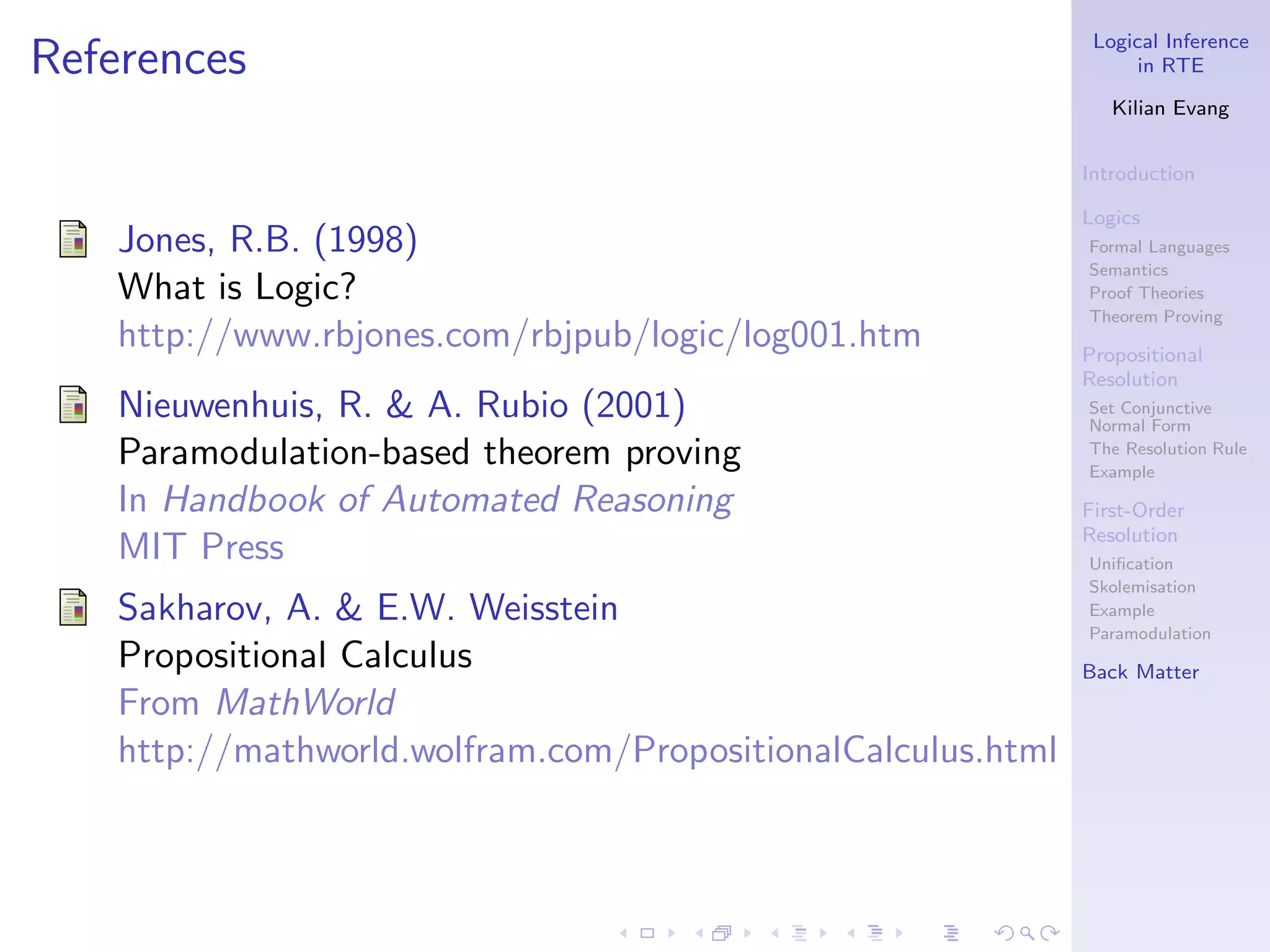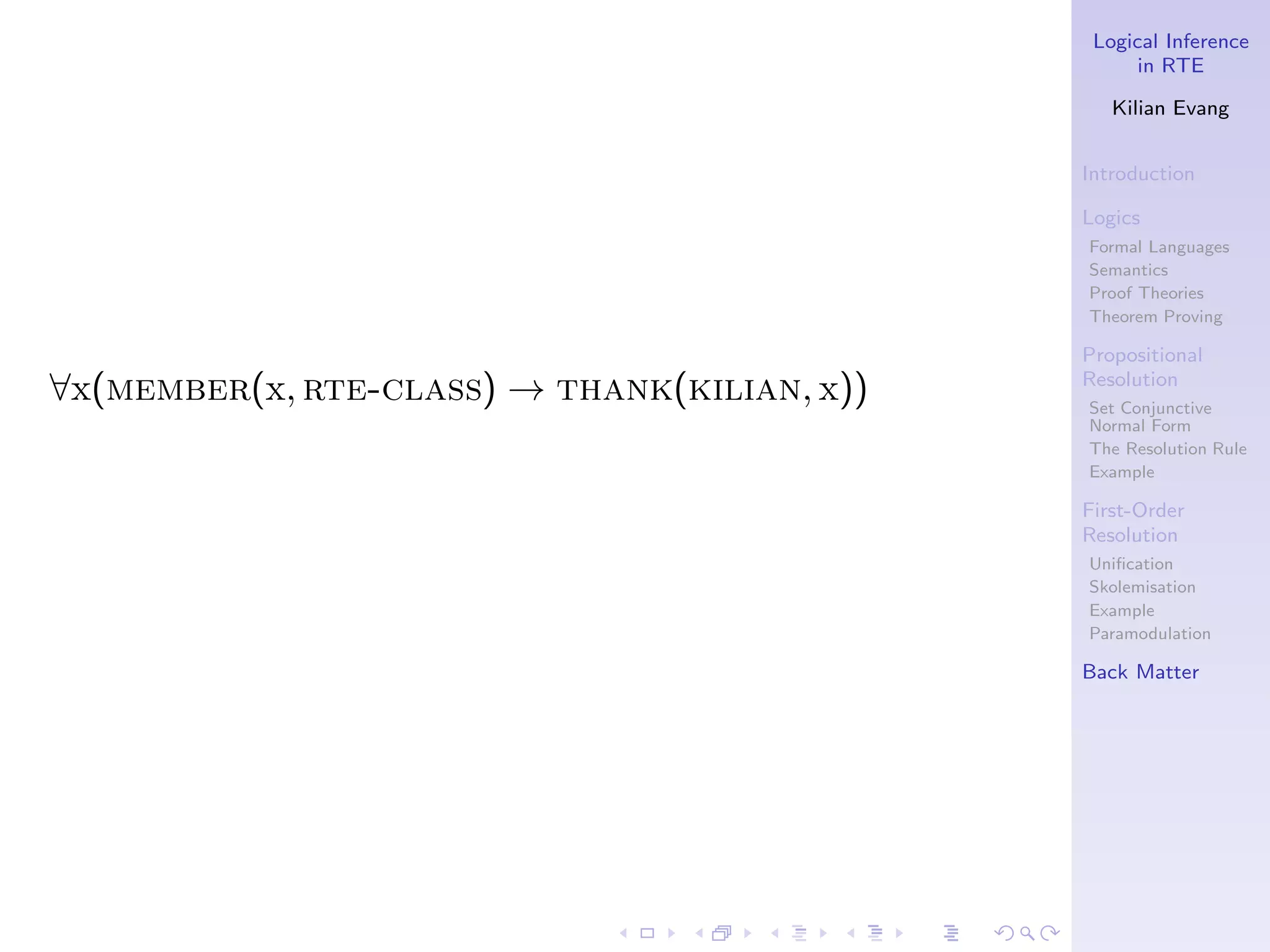This document discusses logical inference in recognizing textual entailment (RTE). It covers topics such as logics, formal languages, semantics, proof theories, propositional and first-order resolution, unification, and paramodulation. The document is authored by Kilian Evang and outlines these topics for applying logical inference to RTE.
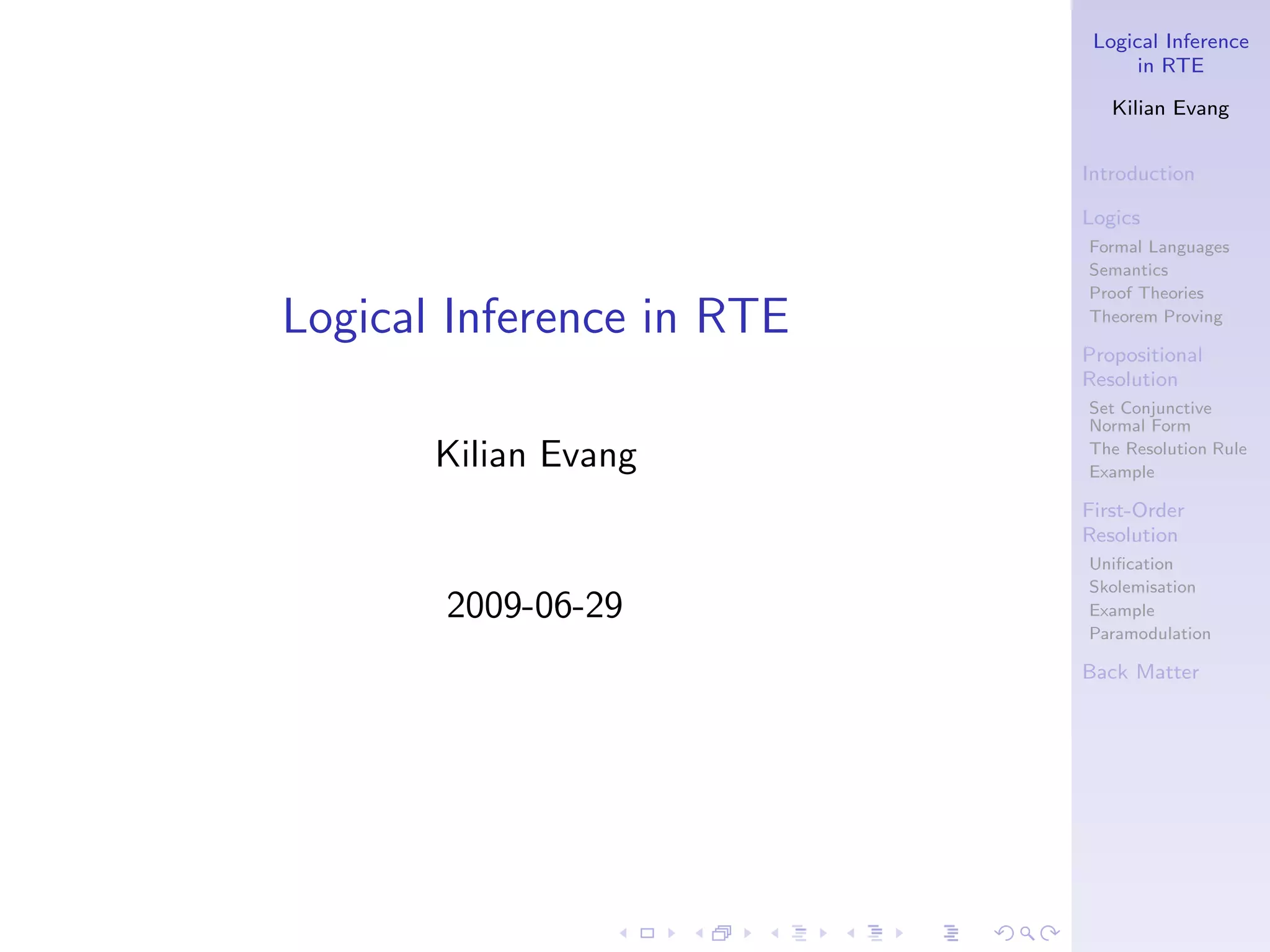

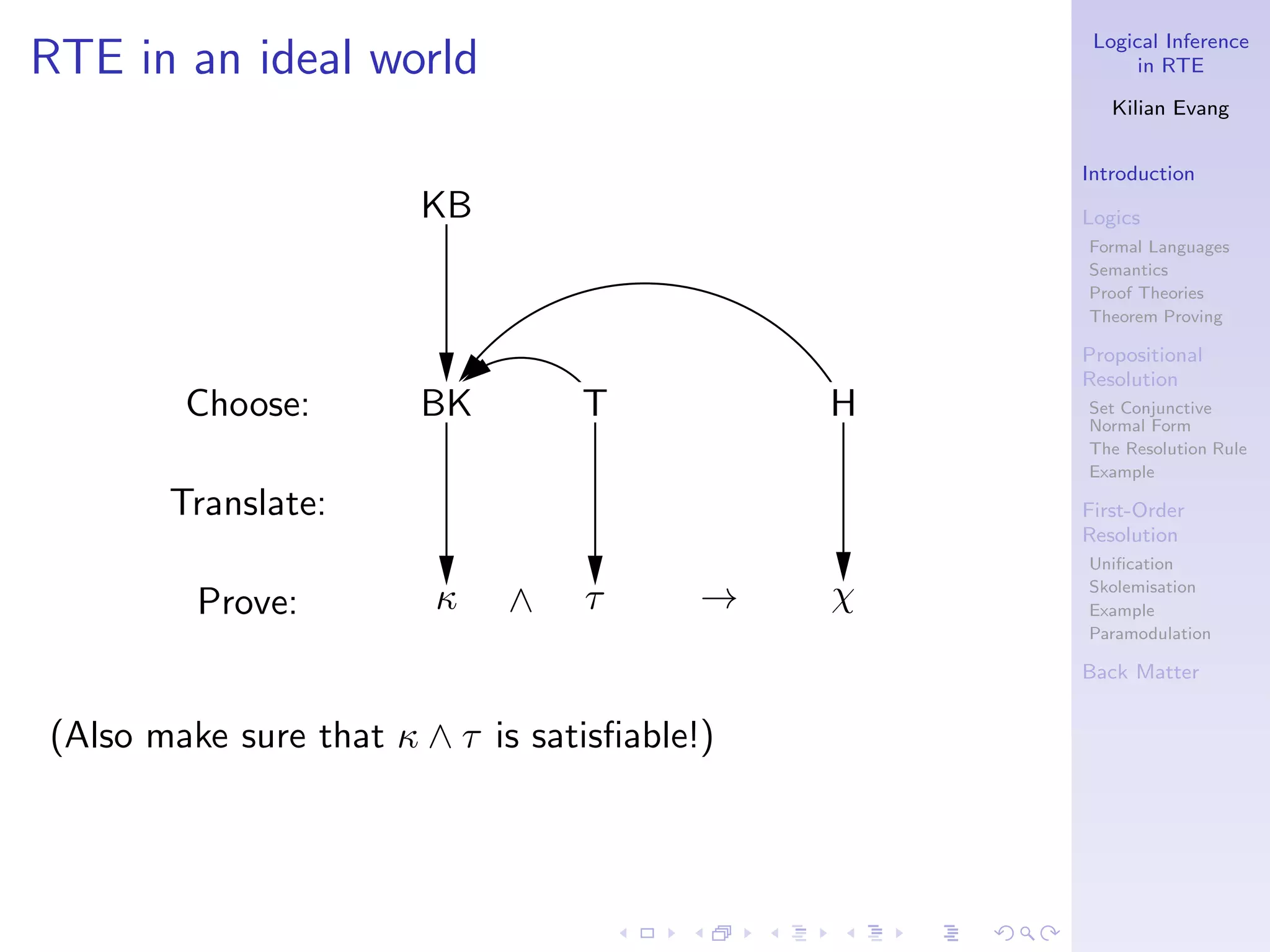
![Logical Inference
Problems in RTE
Kilian Evang
Introduction
Logics
◮ capture the (relevant) subleties of natural language in a Formal Languages
Semantics
logical language Proof Theories
Theorem Proving
◮ encoding a sufficient amount of background knowledge Propositional
Resolution
(offline) Set Conjunctive
Normal Form
◮ choosing the right background knowledge (online) The Resolution Rule
Example
◮ too little: entailment is missed very easily First-Order
◮ remedy 1: turn a blind eye on non-entailment when Resolution
Unification
(minimal) model sizes for T and T+H are very similar Skolemisation
[Bos & Markert, 2005] Example
Paramodulation
◮ remedy 2: use a shallow approach in parallel (ibid.) Back Matter
◮ too much: proving becomes computationally expensive
◮ remedy: very sophisticated reasoning techniques](https://image.slidesharecdn.com/inference-110506122810-phpapp02/75/Logical-Inference-in-RTE-4-2048.jpg)
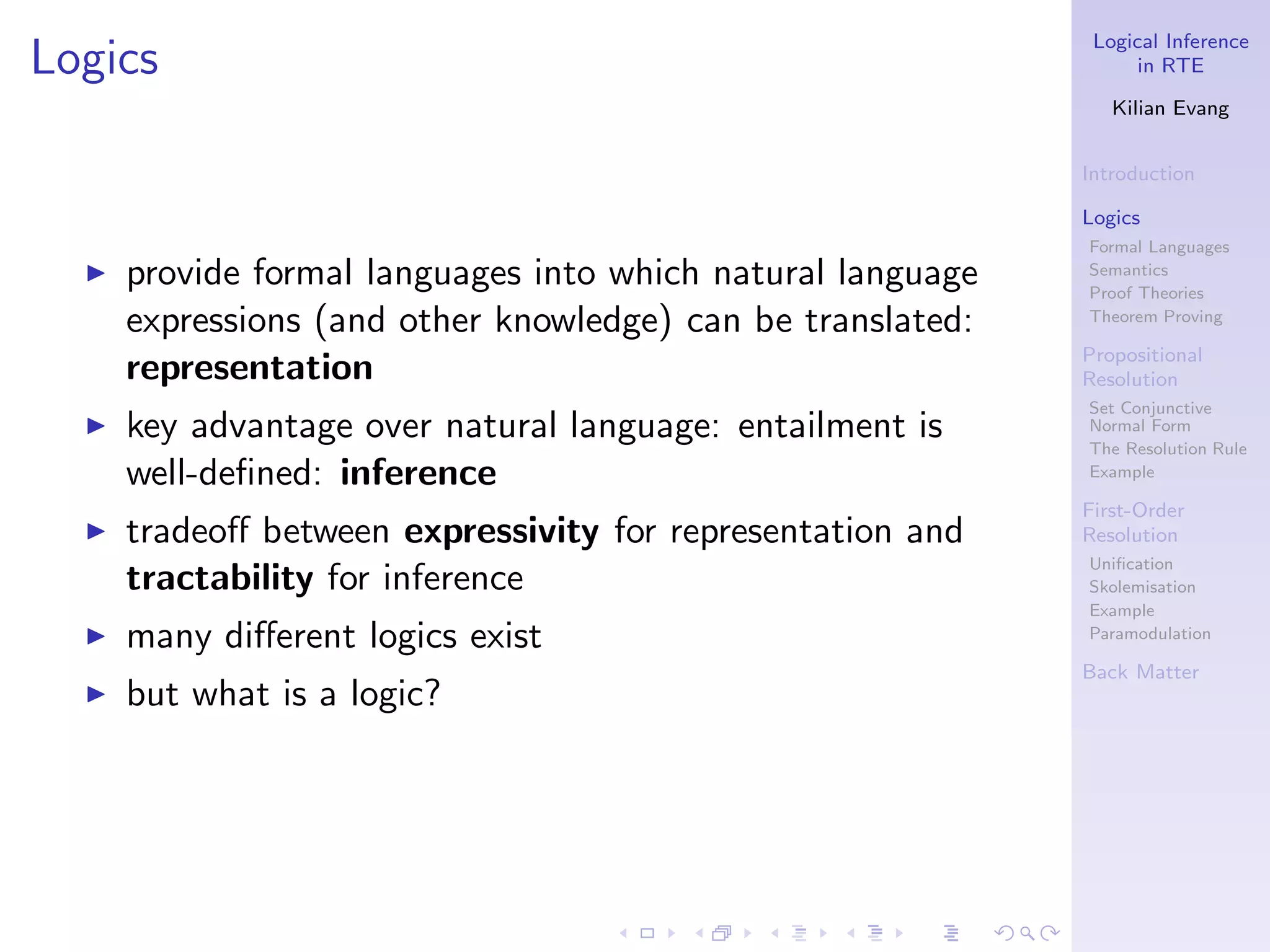
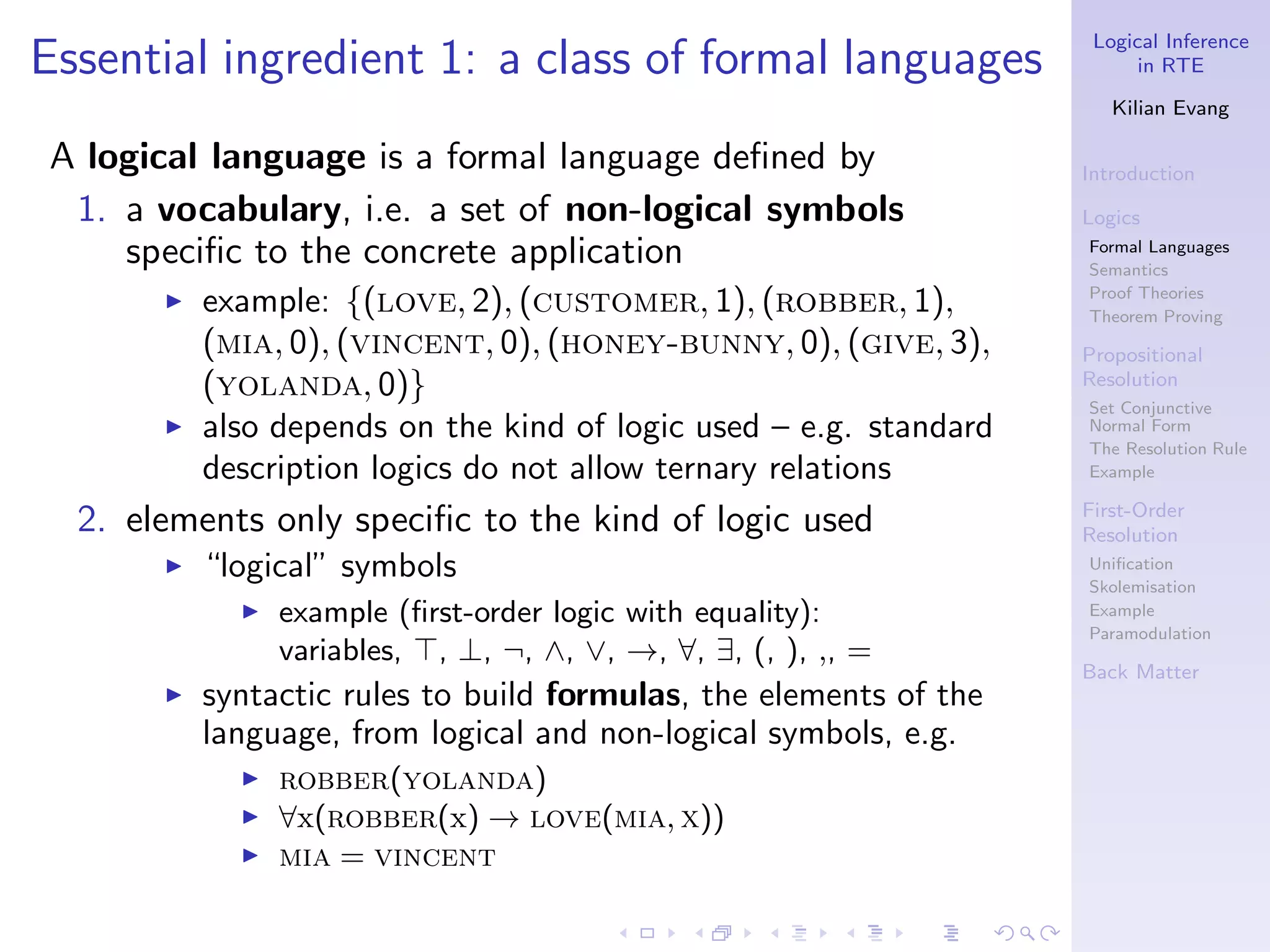

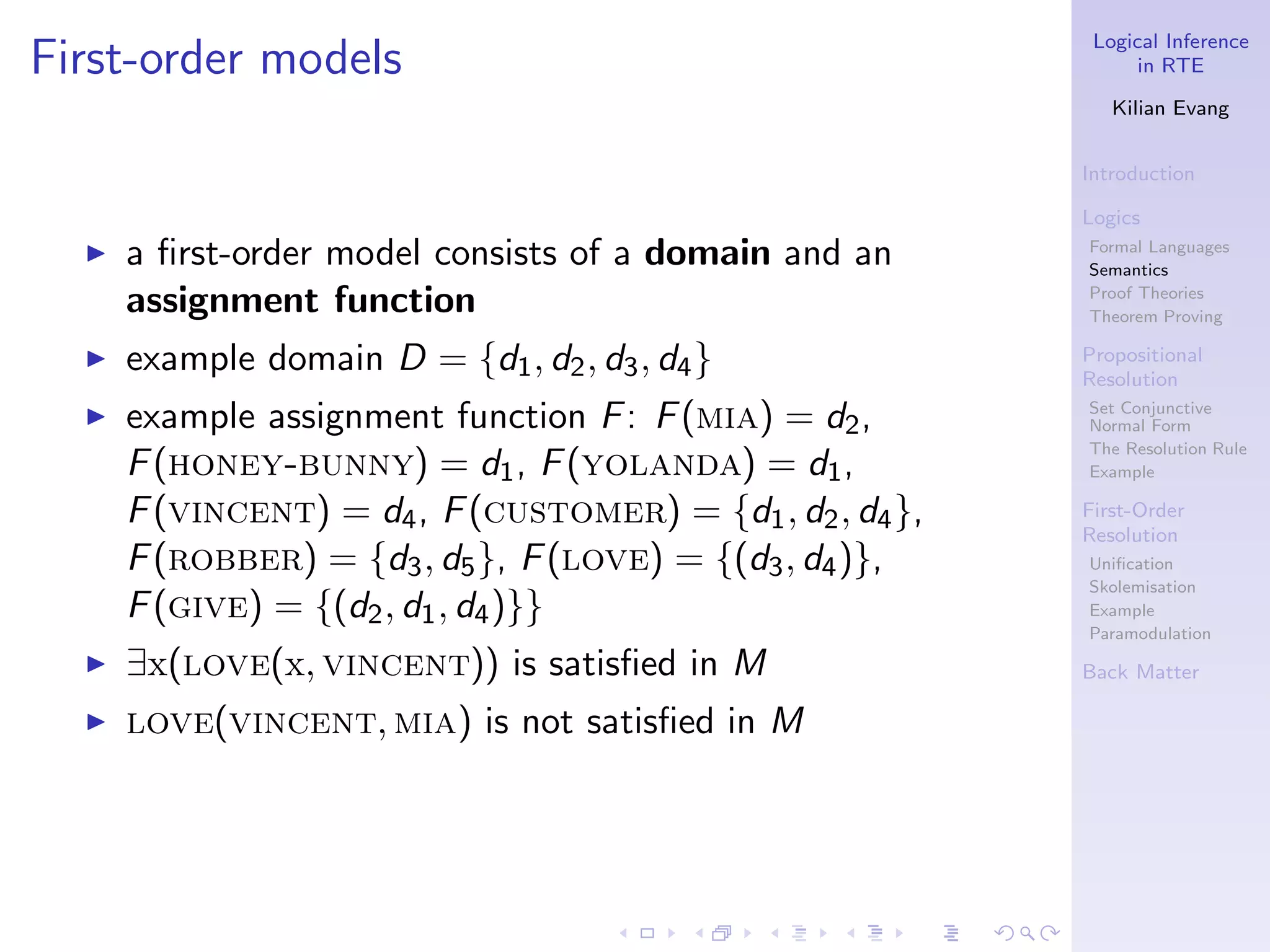
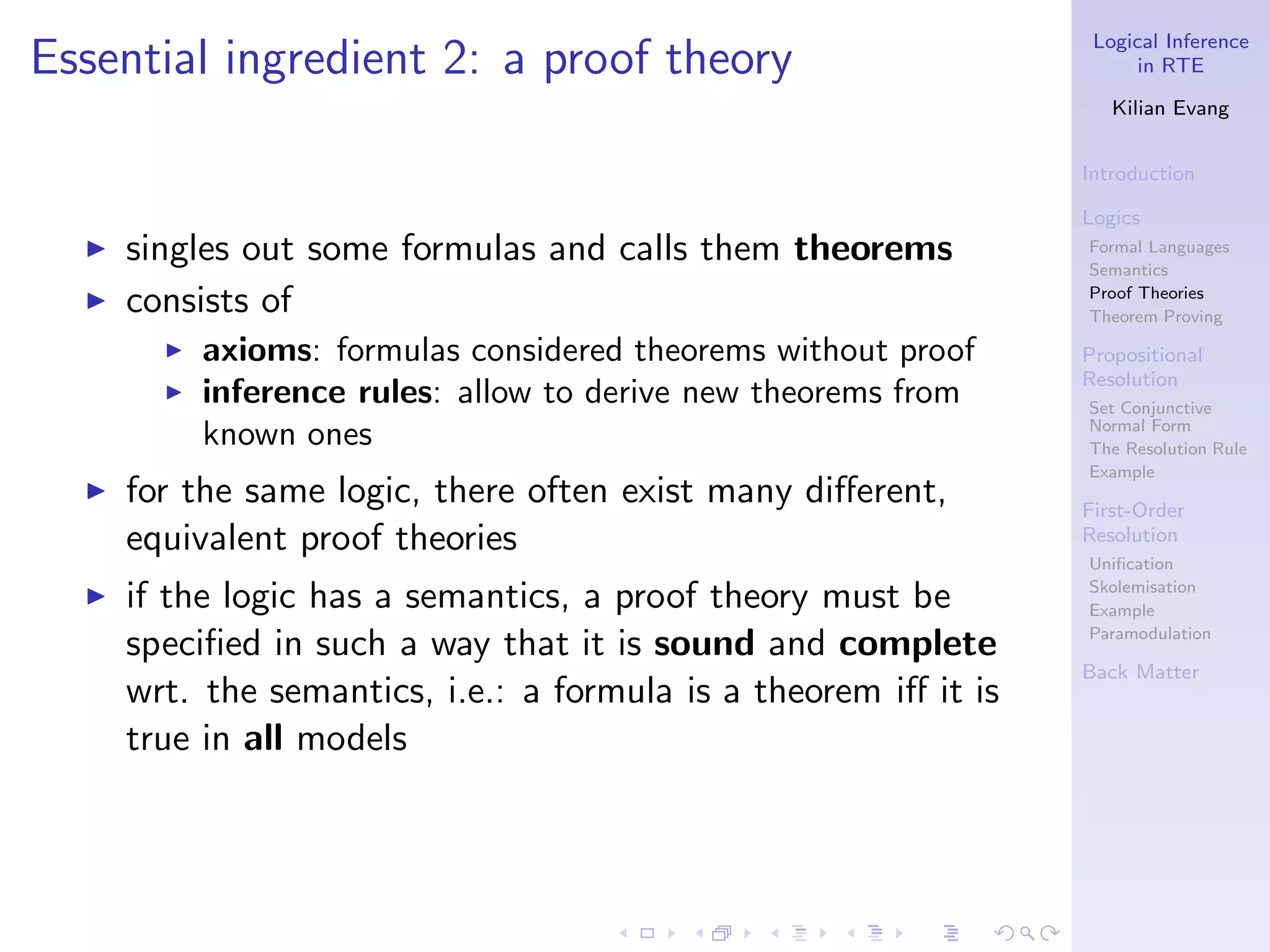
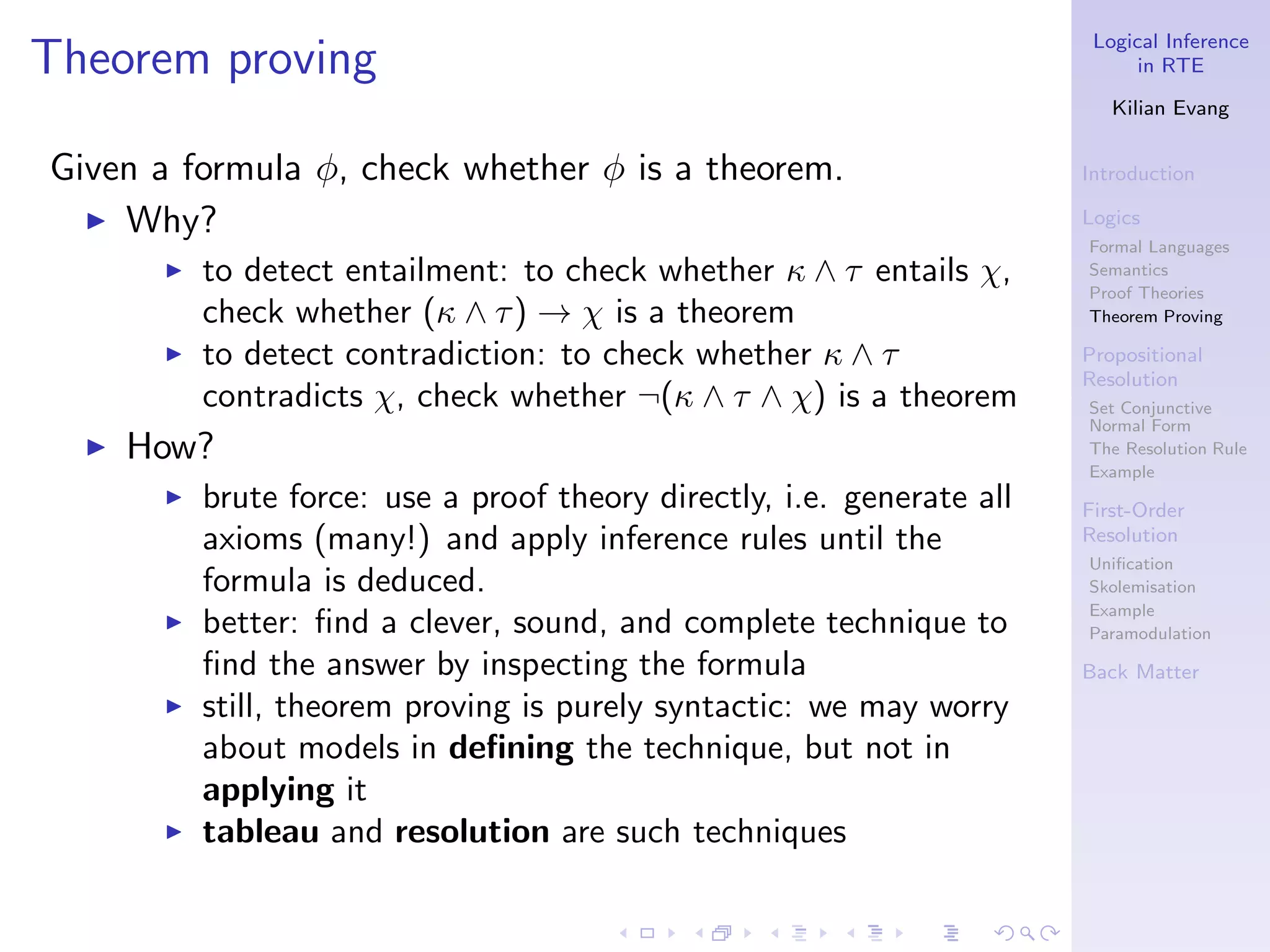
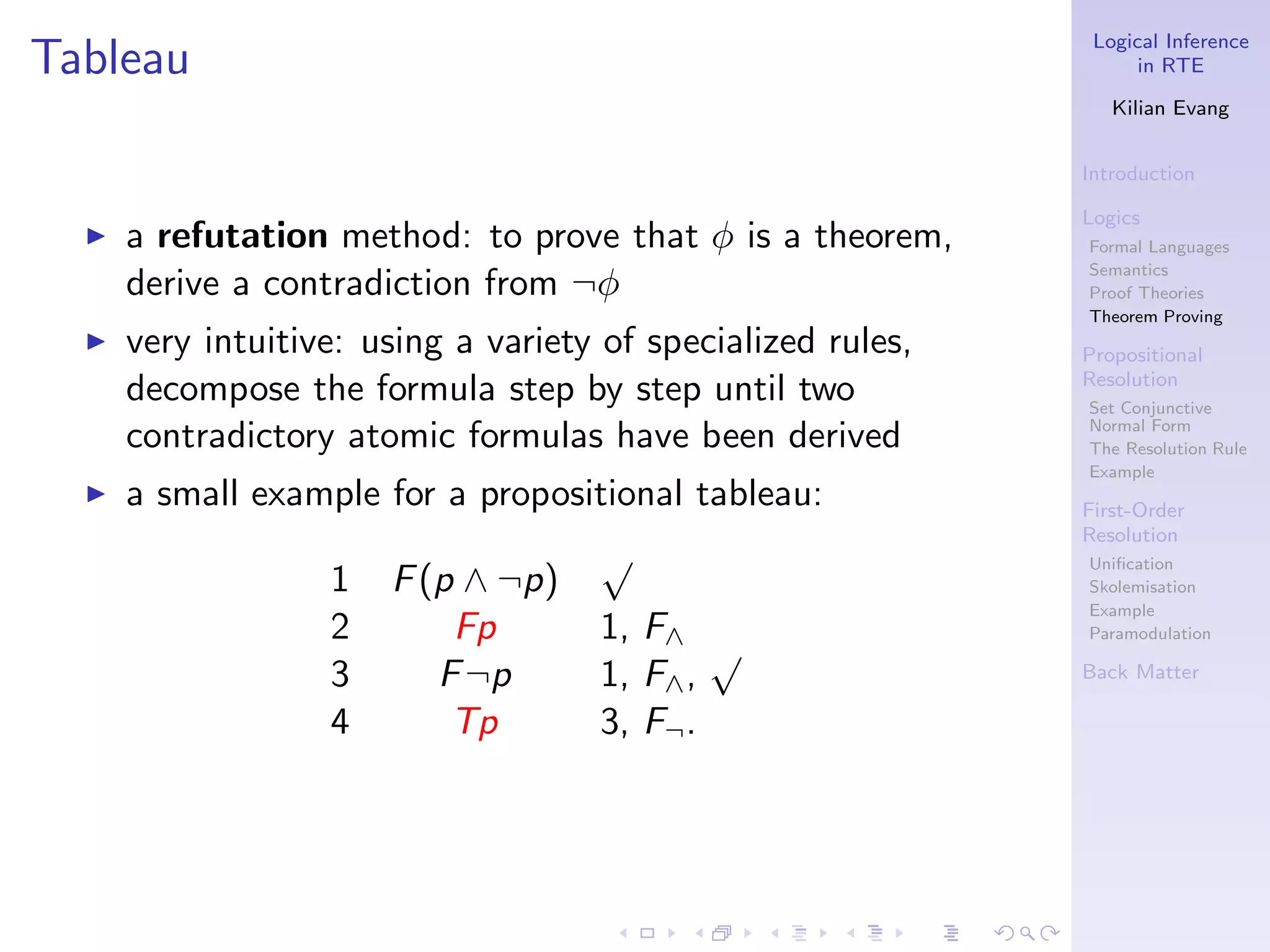
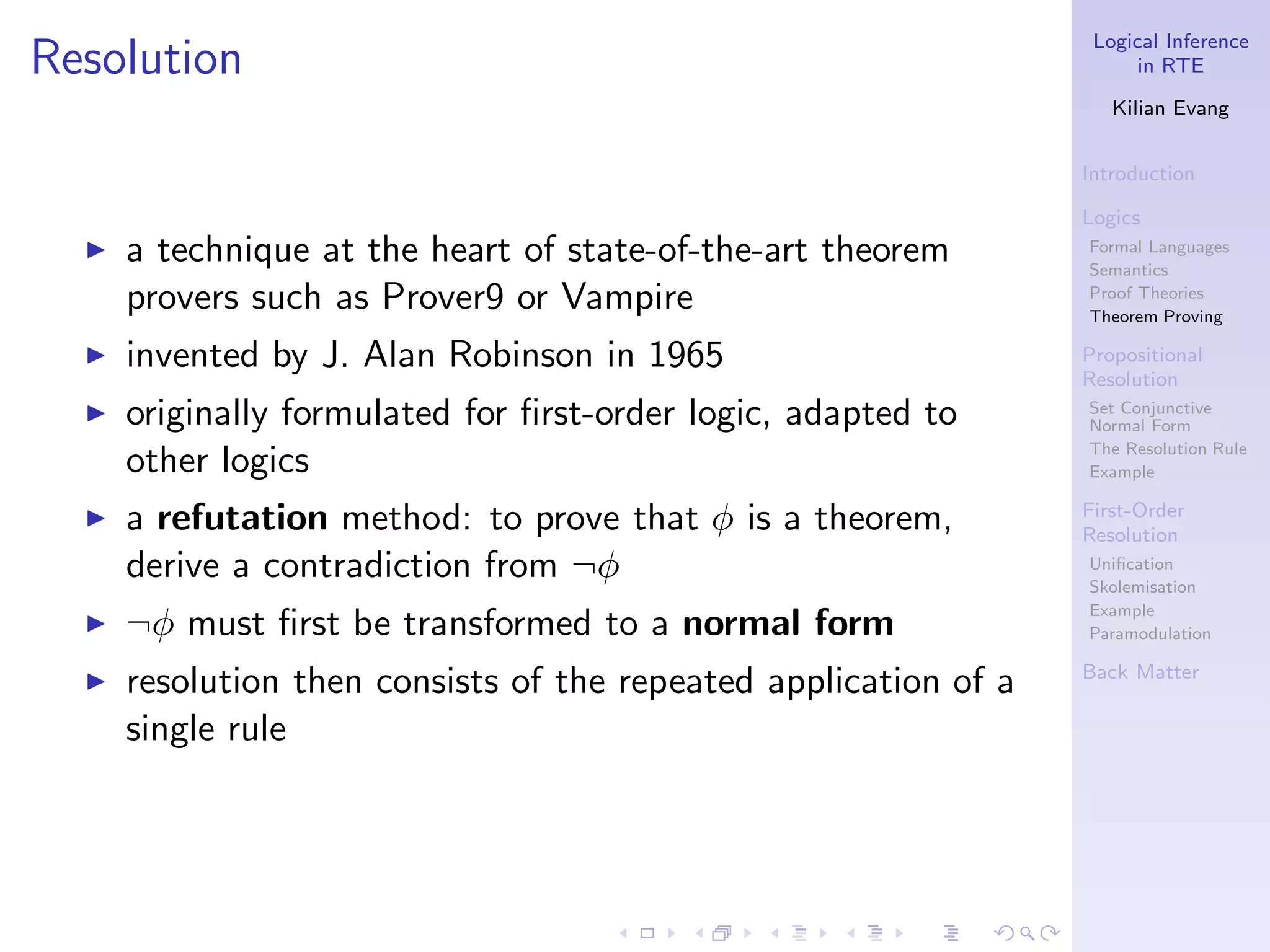
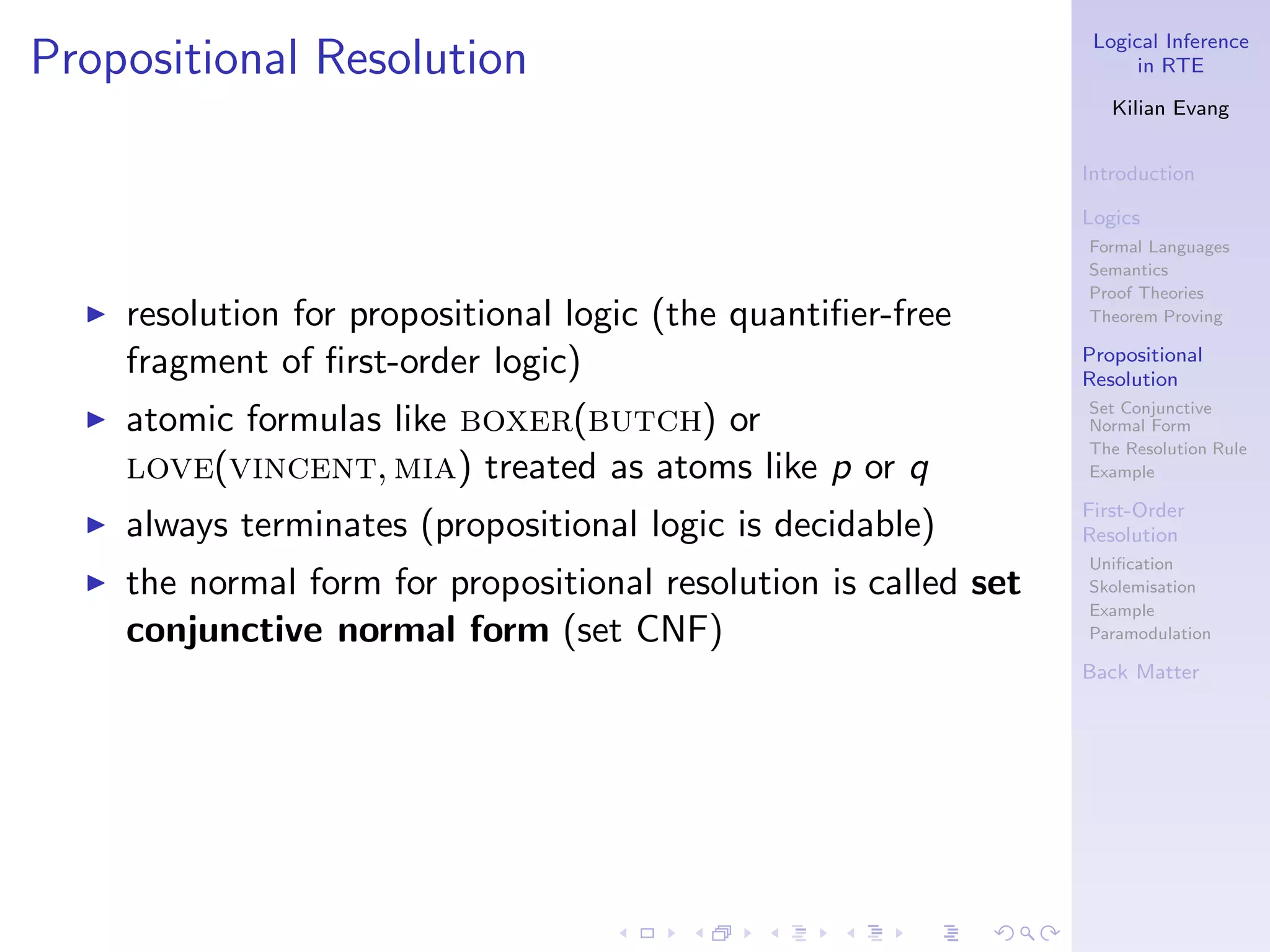
![Logical Inference
Set Conjunctive Normal Form (set CNF) in RTE
Kilian Evang
Introduction
Every formula can be written as a conjunction of
Logics
disjunctions of possibly negated atomic formulas. Formal Languages
A formula that is not in set CNF: Semantics
Proof Theories
Theorem Proving
Propositional
(¬p → q) → (¬r → s) Resolution
Set Conjunctive
Normal Form
The same formula in set CNF: The Resolution Rule
Example
First-Order
Resolution
((¬p ∨ r ∨ s) ∧ (¬q ∨ r ∨ s)) Unification
Skolemisation
Example
In list notation: Paramodulation
Back Matter
[[¬p, r , s], [¬q, r , s]]
The inner lists (conjuncts, disjunctions) are called clauses.](https://image.slidesharecdn.com/inference-110506122810-phpapp02/75/Logical-Inference-in-RTE-14-2048.jpg)
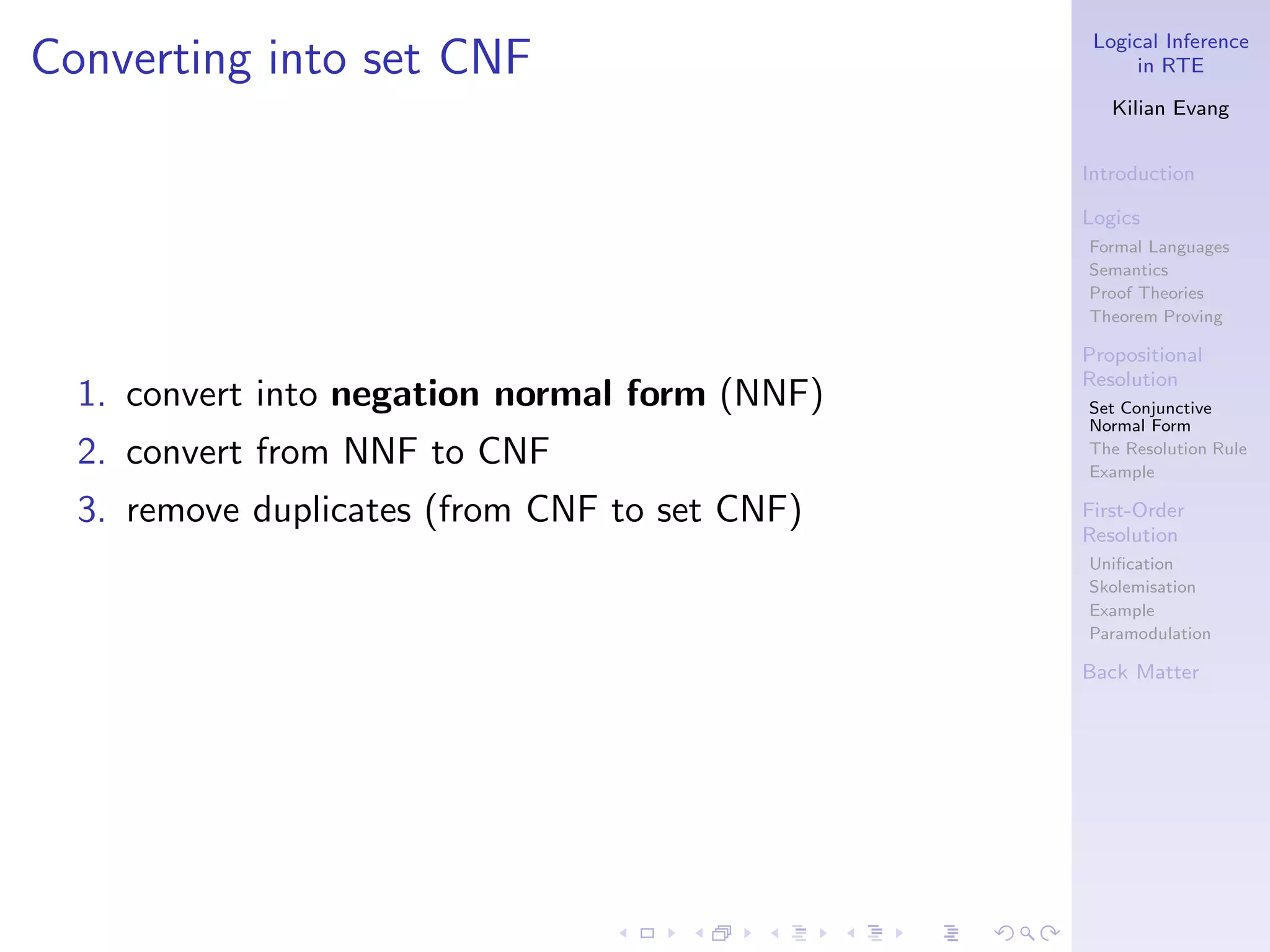

![Logical Inference
Step 2: From NNF to CNF in RTE
Kilian Evang
Rules Introduction
Logics
1. Rewrite θ ∨ (φ ∧ ψ) as (θ ∨ φ) ∧ (θ ∨ ψ) Formal Languages
Semantics
2. Rewrite (φ ∧ ψ) ∨ θ as (φ ∨ θ) ∧ (ψ ∨ θ) Proof Theories
Theorem Proving
3. Rewrite (φ ∧ ψ) ∧ θ as θ ∧ (φ ∧ ψ) Propositional
Resolution
4. Rewrite (φ ∨ ψ) ∨ θ as θ ∨ (φ ∨ ψ) Set Conjunctive
Normal Form
The Resolution Rule
Example
Example First-Order
Resolution
Unification
Skolemisation
Example
Paramodulation
(¬p ∧ ¬q) ∨ (r ∨ s) Back Matter
2 ⇔ (¬p ∨ (r ∨ s)) ∧ (¬q ∨ (r ∨ s))
Set notation: [[¬p, r , s], [¬q, r , s]]
No duplicates, already in set CNF.](https://image.slidesharecdn.com/inference-110506122810-phpapp02/75/Logical-Inference-in-RTE-17-2048.jpg)
![Logical Inference
Step 3: From CNF to set CNF in RTE
Kilian Evang
Introduction
Logics
Formal Languages
Remove duplicate literals from each clause, e.g.: Semantics
Proof Theories
Theorem Proving
[[p, q, r , ¬s], [p, ¬q, p, ¬r ]] Propositional
Resolution
⇔ [[p, q, r , ¬s], [p, ¬q, ¬r ]] Set Conjunctive
Normal Form
The Resolution Rule
Example
Remove duplicate clauses from the list, e.g. First-Order
Resolution
Unification
[[t, ¬r ], [p, q, ¬r ], [t, ¬r ]] Skolemisation
Example
Paramodulation
⇔ [[t, ¬r ], [p, q, ¬r ]]
Back Matter](https://image.slidesharecdn.com/inference-110506122810-phpapp02/75/Logical-Inference-in-RTE-18-2048.jpg)
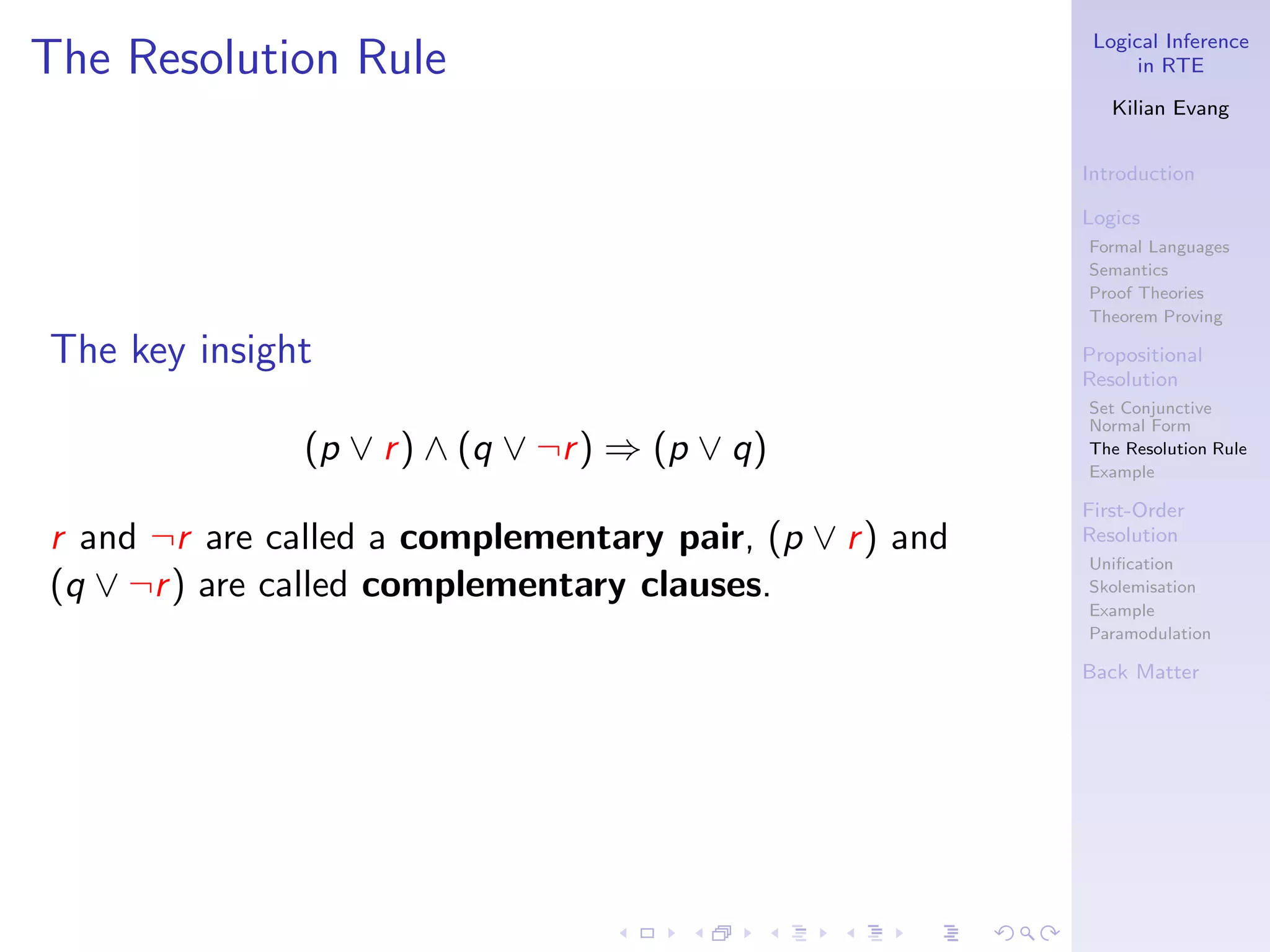
![Logical Inference
The Resolution Rule in RTE
Kilian Evang
From two complementary clauses Introduction
[p1 , · · · , pn , r , pn+1 , · · · , pm ] and Logics
Formal Languages
[q1 , · · · , qj , ¬r , qj+1 , · · · , qk ], deduce Semantics
Proof Theories
[p1 , · · · , pn , pn+1 , · · · , pm , q1 , · · · , qj , qj+1 , · · · , qk ] Theorem Proving
Propositional
Resolution
Set Conjunctive
The process of resolution Normal Form
The Resolution Rule
Example
1. apply the resolution rule to some pair of complementary First-Order
Resolution
clauses Unification
Skolemisation
2. remove duplicates from the result Example
Paramodulation
3. add the result to the set of clauses Back Matter
4. start over, unless
◮ the empty clause has been derived (success)
◮ no unprocessed complementary pair remains (failure)](https://image.slidesharecdn.com/inference-110506122810-phpapp02/75/Logical-Inference-in-RTE-20-2048.jpg)
![Logical Inference
Example in RTE
Kilian Evang
Suppose we want to prove the following formula:
Introduction
(p ∨ (q ∧ r )) → ((p ∨ q) ∧ (p ∨ r )) Logics
Formal Languages
Semantics
Proof Theories
The first step is to transform its negation into set CNF: Theorem Proving
Propositional
Resolution
¬((p ∨ (q ∧ r )) → ((p ∨ q) ∧ (p ∨ r ))) Set Conjunctive
Normal Form
⇔ (p ∨ (q ∧ r )) ∧ ¬((p ∨ q) ∧ (p ∨ r )) The Resolution Rule
Example
⇔ (p ∨ (q ∧ r )) ∧ (¬(p ∨ q) ∨ ¬(p ∨ r )) First-Order
Resolution
⇔ (p ∨ (q ∧ r )) ∧ ((¬p ∧ ¬q) ∨ (¬p ∧ ¬r )) Unification
Skolemisation
Example
⇔ ((p ∨ q) ∧ (p ∨ r )) ∧ (((¬p ∧ ¬q) ∨ ¬p) ∧ ((¬p ∧ ¬q) ∨ ¬r ))
Paramodulation
⇔ ··· Back Matter
⇔ ((p ∨ q) ∧ (p ∨ r ) ∧ (¬p ∨ ¬p) ∧ (¬p ∨ ¬r ) ∧ (¬q ∨ ¬p) ∧ (¬q ∨ ¬r ))
CNF: [[p, q], [p, r ], [¬p, ¬p], [¬p, ¬r ], [¬q, ¬p], [¬q, ¬r ]]
Set CNF: [[p, q], [p, r ], [¬p], [¬p, ¬r ], [¬q, ¬p], [¬q, ¬r ]]](https://image.slidesharecdn.com/inference-110506122810-phpapp02/75/Logical-Inference-in-RTE-21-2048.jpg)
![Logical Inference
Example in RTE
Kilian Evang
Introduction
Logics
Formal Languages
Then we apply the resolution rule until we derive the empty Semantics
Proof Theories
clause or no unprocessed complementary pair remains: Theorem Proving
Propositional
Resolution
[[p, q], [p, r ], [¬p], [¬p, ¬r ], [¬q, ¬p], [¬q, ¬r ]] Set Conjunctive
Normal Form
⇔ [[p, q], [p, r ], [¬p], [¬p, ¬r ], [¬q, ¬p], [¬q, ¬r ], [q]] The Resolution Rule
Example
⇔ [[p, q], [p, r ], [¬p], [¬p, ¬r ], [¬q, ¬p], [¬q, ¬r ], [q], [r ]] First-Order
Resolution
⇔ [[p, q], [p, r ], [¬p], [¬p, ¬r ], [¬q, ¬p], [¬q, ¬r ], [q], [r ], [¬r ]] Unification
Skolemisation
Example
⇔ [[p, q], [p, r ], [¬p], [¬p, ¬r ], [¬q, ¬p], [¬q, ¬r ], [q], [r ], [¬q], []] Paramodulation
Back Matter
Success!](https://image.slidesharecdn.com/inference-110506122810-phpapp02/75/Logical-Inference-in-RTE-22-2048.jpg)

![Logical Inference
Unification in a nutshell in RTE
Kilian Evang
Introduction
◮ making two terms identical by replacing variables,
Logics
using the most general substitution possible Formal Languages
Semantics
◮ robber(vincent) and customer(x) Proof Theories
Theorem Proving
are not unifiable: different relation symbols Propositional
Resolution
◮ robber(vincent) and robber(mia) Set Conjunctive
Normal Form
are not unifiable: different constant arguments The Resolution Rule
Example
◮ love(x, y) and love(mia, z) are unifiable. Which First-Order
substitution? Resolution
Unification
◮ [x/mia, y/vincent, z/vincent]? Skolemisation
Example
Bad idea, too specific. Paramodulation
◮ [x/mia, y/z] is the most general unifier (mgu). Back Matter
Result: love(mia, z)
◮ also: love(father(x), mia) and love(x, mia) are not
unifiable: would create a cycle (“occurs check” needed)](https://image.slidesharecdn.com/inference-110506122810-phpapp02/75/Logical-Inference-in-RTE-24-2048.jpg)
![Logical Inference
Resolution with unification in RTE
Kilian Evang
Introduction
Logics
Formal Languages
Semantics
Proof Theories
◮ example: ∀x(love(x, mia)) ∧ ¬love(vincent, mia) Theorem Proving
Propositional
◮ we should be able to refute that Resolution
Set Conjunctive
◮ normal form: [[love(x, mia)], [¬love(vincent, mia)]] Normal Form
The Resolution Rule
Example
◮ what tells us there’s a contradicition here – after we
First-Order
dropped the universal quantifier? Resolution
Unification
◮ it’s the fact that the terms can be unified – we are Skolemisation
Example
allowed to treat this as a complementary pair Paramodulation
Back Matter](https://image.slidesharecdn.com/inference-110506122810-phpapp02/75/Logical-Inference-in-RTE-25-2048.jpg)
![Logical Inference
Non-redundant factors in RTE
Kilian Evang
Introduction
◮ whenever adding a new clause in propositional
Logics
resolution, we need to remove duplicates inside it Formal Languages
Semantics
◮ in first-order resolution, we also need to take care of Proof Theories
Theorem Proving
terms that could become duplicates by unification Propositional
Resolution
◮ example: Set Conjunctive
Normal Form
[A(m), A(y), B(n, x), B(y, z), ¬C (w), ¬C (f (z))] The Resolution Rule
Example
◮ two possible most general variable substitutions that First-Order
make the clause non-redundant: Resolution
Unification
◮ [y/m, w/f (z)] Skolemisation
Example
◮ [y/n, z/x, w/f (z)] Paramodulation
Back Matter
◮ both must be used, resulting non-redundant factors
are added to the list of clauses:
◮ [A(m), B(n, x), B(m, z), ¬C (f (z))]
◮ [A(m), A(n), B(n, x), ¬C (f (x))]](https://image.slidesharecdn.com/inference-110506122810-phpapp02/75/Logical-Inference-in-RTE-26-2048.jpg)
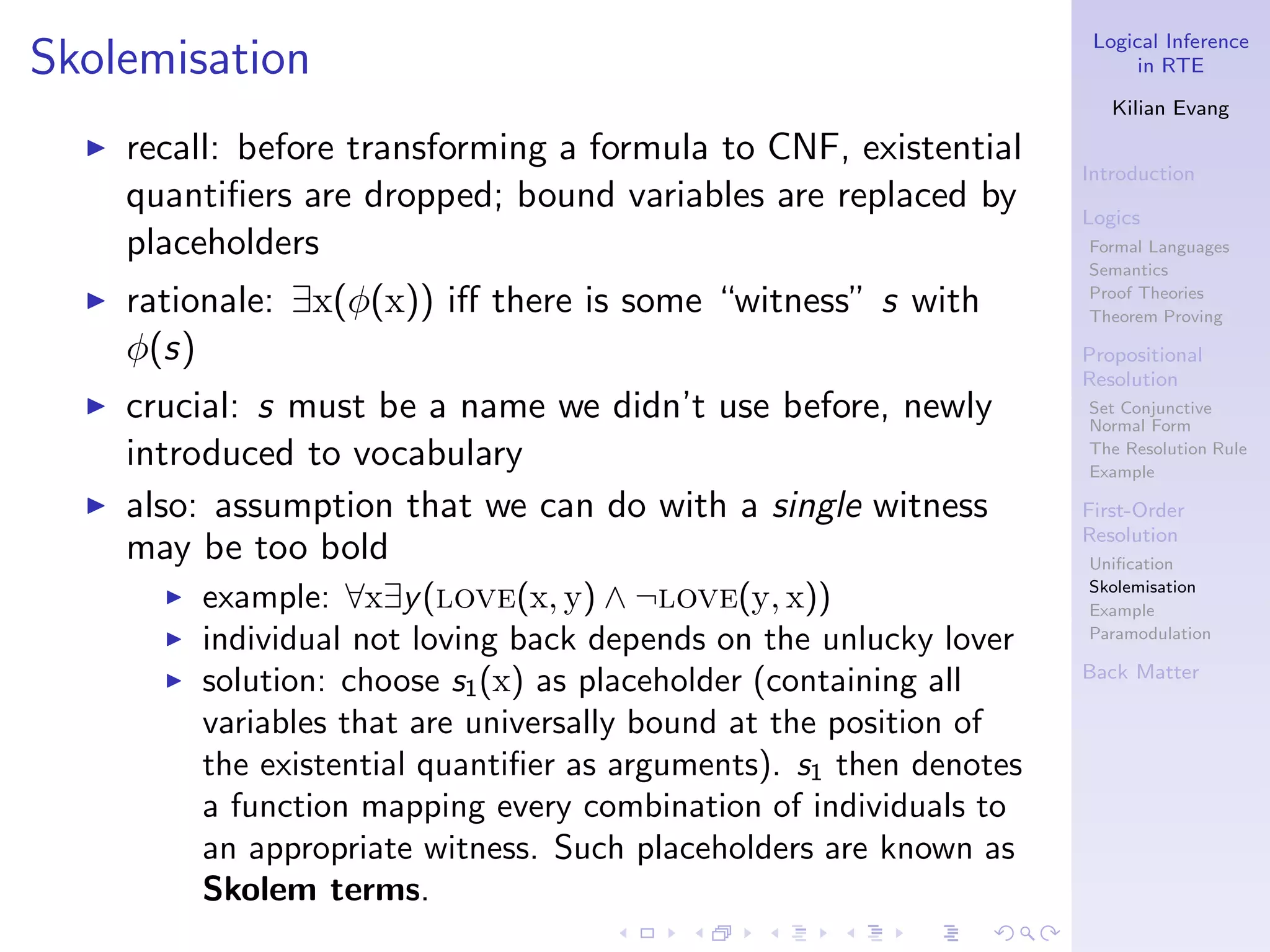
![Logical Inference
in RTE
Formula to prove: ∀y¬∃xlove(x, y) → ¬∃x∀ylove(x, y) Kilian Evang
Negate: ¬(∀y¬∃xlove(x, y) → ¬∃x∀ylove(x, y))
Introduction
Convert to negation normal form:
Logics
∀y¬∃xlove(x, y) ∧ ¬¬∃x∀ylove(x, y) Formal Languages
∀y∀x¬love(x, y) ∧ ¬¬∃x∀ylove(x, y) Semantics
Proof Theories
∀y∀x¬love(x, y) ∧ ∃x∀ylove(x, y) Theorem Proving
Propositional
Skolemize away existential quantifiers (no arguments Resolution
Set Conjunctive
necessary in Skolem term since the existentially quantified Normal Form
The Resolution Rule
formula is not in the scope of a universally quantified one): Example
∀y∀x¬love(x, y) ∧ ∀ylove(s1 , y) First-Order
Resolution
Drop universal quantifiers and rename variables: Unification
Skolemisation
¬love(x, y) ∧ love(s1 , z) Example
Paramodulation
Already in set clause normal form – write in list notation: Back Matter
[[¬love(x, y)], [love(s1 , z)]]
Apply resolution with unification (mgu: [x/s1 , y/z]):
[[¬love(x, y)], [love(s1 , z)], []]
Success!](https://image.slidesharecdn.com/inference-110506122810-phpapp02/75/Logical-Inference-in-RTE-28-2048.jpg)
![Logical Inference
Paramodulation in RTE
Kilian Evang
Introduction
Logics
◮ technique as described cannot deal with equality Formal Languages
Semantics
◮ example: Proof Theories
Theorem Proving
(yolanda = honey-bunny ∧ robber(yolanda)) → Propositional
robber(honey-bunny) is a theorem, but will not be Resolution
Set Conjunctive
proved if = is treated as just another binary predicate Normal Form
The Resolution Rule
Example
◮ state-of-the-art theorem provers use an additional rule, First-Order
paramodulation Resolution
Unification
Skolemisation
◮ given A = B, permits to substitute B for terms unifiable Example
Paramodulation
with A in formulas
Back Matter
◮ intelligent restrictions needed to counter explosion of
search space, see [Nieuwenhuis & Rubio, 2001]](https://image.slidesharecdn.com/inference-110506122810-phpapp02/75/Logical-Inference-in-RTE-29-2048.jpg)
![Logical Inference
The paramodulation rule in RTE
Kilian Evang
Introduction
Logics
Formal Languages
Semantics
Proof Theories
Theorem Proving
Propositional
Resolution
From two clauses [s = t, φ] and [ψ, θ] where some r in ψ is Set Conjunctive
Normal Form
unifiable with s with the most general unifier σ, deduce The Resolution Rule
Example
[φ, ψ[r/s], θ]σ. First-Order
Resolution
Unification
Skolemisation
Example
Paramodulation
Back Matter](https://image.slidesharecdn.com/inference-110506122810-phpapp02/75/Logical-Inference-in-RTE-30-2048.jpg)
